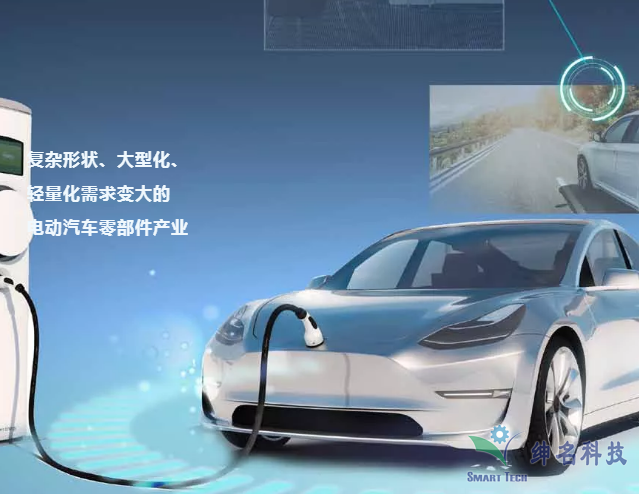06
2022
-
01
Industry Dynamics | Growth of the New Energy Vehicle Industry and Processing Solutions
The trends of 'CASE' (Connected, Automated, Shared, Electric) and 'digital transformation' have brought significant changes not only to the complete vehicle industry but also to the automotive parts industry.
The technical capability of multi-axis machining equipment and aluminum material processing is key.

The trends of Connected, Automated, Shared, and Electric (CASE) and digital transformation have brought significant changes not only to the automotive industry but also to the automotive parts industry.
Not only are new materials and new shapes of components emerging, but the quality demands for lightweight and high-rigidity components are also increasing.
Currently, internal combustion engine vehicles still account for 80% of total automotive production, and the environmentally friendly vehicles that are expected to grow continuously, as well as the automotive parts industry that is undergoing foreseeable changes, are now in a transition period. What role should machine tools play in ensuring sustainable competitiveness in the automotive parts processing industry during this transition?
No.1 Challenges Facing the Industry
"60% of internal combustion engine vehicle parts will disappear"
It is necessary to pay attention to the expanding demand for new automotive parts materials processing and equipment.
With the transition from internal combustion engine vehicles to environmentally friendly vehicles such as electric or hydrogen vehicles, it is predicted that more than 60%, or about 10,000 internal combustion engine vehicle parts, will disappear.
In contrast, the new electrical components related to electric vehicles, such as motors, batteries, and sensors, are only about 2,000. This phenomenon is not only due to the increase in the production of environmentally friendly vehicles but also because of the electrification trend of original internal combustion engine vehicle parts. For example, electric vehicles eliminate all engine components, and there is also a reduction in components related to the drive system or transmission and braking systems.
Up to 15 components installed in the power system, such as cylinder blocks, cylinder heads, seat plates, transmission cases, shafts, gears, turbochargers, and oil pumps, are replaced by the housing and covers of the motor, as well as the electrical and electronic housings and covers.
GANG HYUNJUNG, Deputy Director of Market Intelligence at Doosan Machine Tools, emphasized that "the transition from internal combustion engine vehicles to electric vehicles cannot simply be seen as a change in the number of parts." Deputy Director GANG added that "the machine tool and machining industry must also consider the demand for 'electric vehicle parts processing' and the demand for 'equipment industry' to produce new parts and materials, and think about the ripple effects on the entire electric vehicle industry."
No.2 Consumer-Oriented Solutions
Addressing the "complexity of part shapes" and "lightweighting of parts and materials" through five-axis or multi-axis machining equipment to meet the demand for long and large components in electric vehicles.
Not to mention the demand for equipment used to produce parts and materials, the changes in the requirements for "automotive parts processing" during the transition to electric vehicles include the 'emergence of new parts' and the 'complexity of part shapes', as well as 'lightweighting of parts and materials'.
From the perspective of the reduction in the number of parts that are receiving attention, steel parts are reduced by about 75%, while aluminum and cast iron parts are reduced by about 27% and 14%, respectively. It is particularly noteworthy that, in order to achieve lightweighting, steel and cast iron are being replaced by aluminum or aluminum alloys.
HEO YEONGLOK, Head of the Application Engineering Department at Doosan Machine Tools, stated, "As the electric vehicle market continues to grow, companies that have five-axis or multi-axis machining equipment will have a significant competitive advantage when processing long and large components related to batteries and motors or vehicle body frames."
No.3 Future Market Outlook
Major countries around the world that are expected to continue expanding electric vehicle production are interrupting or reducing internal combustion engine vehicle production and announcing plans to replace them with electric vehicles.
Due to further strengthening of carbon emission regulations and the support policies for environmentally friendly vehicles in major countries, the demand for electric vehicles is expected to further expand.
Centered in Europe, major countries have set and announced goals to interrupt the production of internal combustion engine vehicles from 2025 to 2040 and fully replace them with electric vehicles. Norway aims to phase out internal combustion engine vehicle production by 2025, while Germany and Japan aim for 2030, and the UK by 2040. In line with this trend, Hyundai Motor plans to launch 560,000 electric vehicles by 2025, and Kia plans to launch 500,000 by 2026, selling them in the global market.
"The trend of electrification may bring changes to all mobile tools equipped with internal combustion engines, so we should not limit ourselves to electric vehicles but pay attention to various industries, customers, and regions, and it is necessary to broaden our perspective."
—— GANG HYUNJUNG, Deputy Director of Doosan Machine Tools Marketing Department
More news


